Welcome to Part 2 of It’s Research, I Swear. Last week I touched on some not-so-usual adventures I’ve had researching and influencing my books. You can read about them here. But sometimes research can take us places far from home…
One drawback of writing historical fiction of any kind is that you don’t get to experience what life was like in the past. Add into the mix, stories that take place in a city or country that you’ve never visited and you understand the predicament I’m in.
I’ve always liked to travel. To me, travel is a grand adventure and a chance to learn and experience something new. I knew as soon as I started writing this series that I would have to make the journey to London. Sooner, rather than later. So when the opportunity presented itself, I took my first solo trip abroad and spent 10 days in London and the South of England…for research purposes. Yeah, that’s it…
So when the opportunity presented itself, I took my first solo trip abroad and spent 10 days in London and the South of England. While the entire trip was amazing, it’s primary goal was research. The next four items on my Top Ten Adventures in Research are from that trip.
7. Severs’ House
I knew one of the things I had to see was the Dennis Severs’ House at 18 Folgate street. I came across a reference to the Severs’ House quite by accident. Set up as a living art exhibit, you wander through the house that is 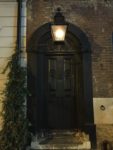 set up as it was in the past. each floor is a different time period and it leads the visitor on a trip through time from the 1600s through the late 1800s. The decor is period specific and there is no electricity in the house. Everything you see is as it was. The wig hanging on the back of the chair, the only lighting coming from candles, sconces and the fire burning in the hearth. You see how the residents prospered in the late 1700s, and declined dramatically in the mid-1800s. You smell the coal burning, you see the bed hangings and clothes draped on the backs of chairs, and even food laid out for an evening’s entertainment. It was like stepping back in time. Like most places in London, photos were not allowed on the inside. :(
set up as it was in the past. each floor is a different time period and it leads the visitor on a trip through time from the 1600s through the late 1800s. The decor is period specific and there is no electricity in the house. Everything you see is as it was. The wig hanging on the back of the chair, the only lighting coming from candles, sconces and the fire burning in the hearth. You see how the residents prospered in the late 1700s, and declined dramatically in the mid-1800s. You smell the coal burning, you see the bed hangings and clothes draped on the backs of chairs, and even food laid out for an evening’s entertainment. It was like stepping back in time. Like most places in London, photos were not allowed on the inside. :(
6. Spencer House
Spencer House has been the London residence of the Spencer family for over 200 years. Commissioned and built for the 1st Earl Spencer in the 1750s, it went on to be one of the most elegant and grand town-homes in London. While still in the Spencer family (yes, the same Spencer family as Princess 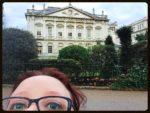 Diana), they have not occupied the house since the 1920s. Following WWII, parts of the house were converted into office spaces. Now, the ground floor and some of the upstairs rooms have been restored to their original Palladian splendor and are open for tours and special events. The colors, decor, furnishings and artwork are mostly original to the home and were discovered beneath the modernization. Many of the characters I write about are upper class and peers, so to see what a period specific residence was like during that time was a special treat. It gave me a better understanding of homes during the time period.
Diana), they have not occupied the house since the 1920s. Following WWII, parts of the house were converted into office spaces. Now, the ground floor and some of the upstairs rooms have been restored to their original Palladian splendor and are open for tours and special events. The colors, decor, furnishings and artwork are mostly original to the home and were discovered beneath the modernization. Many of the characters I write about are upper class and peers, so to see what a period specific residence was like during that time was a special treat. It gave me a better understanding of homes during the time period.
FUN FACT: Spencer House and it’s neighbors border Green Park. Green Park, like many of the other parks within London, are property of the Crown. When the homes were built, they were built to maximize the grandeur of the house. The architect built it right up to the property line, and did not take into account any garden space. When park visitors would walk right up to the homes, the homeowners decided to put up a fence…on royal property. Over the years, the fences would be torn down and built back up. Until an understanding was reached that the homeowners were granted a 100-year lease in order to keep their fences up and people away from the homes.
Sadly, no photos are allowed on the inside of the residence. :(
5. Bath
 Ah, Bath… What can I say about this spa town. It is such a lovely town, built with wide promenades that have not changed much in the past 200+ years. On one of my day trips to the town, someone described it as the “Las Vegas of Georgian England” — it was the getaway destination for both it’s healing waters and it’s vibrant social life. Aside from “taking the waters” at the Pump Rooms (the natural mineral spring was said to cure everything from gout to infertility), residents and visitors would attend the assemblies and for those with a wilder nature, gamble in one of the many hells.
Ah, Bath… What can I say about this spa town. It is such a lovely town, built with wide promenades that have not changed much in the past 200+ years. On one of my day trips to the town, someone described it as the “Las Vegas of Georgian England” — it was the getaway destination for both it’s healing waters and it’s vibrant social life. Aside from “taking the waters” at the Pump Rooms (the natural mineral spring was said to cure everything from gout to infertility), residents and visitors would attend the assemblies and for those with a wilder nature, gamble in one of the many hells.
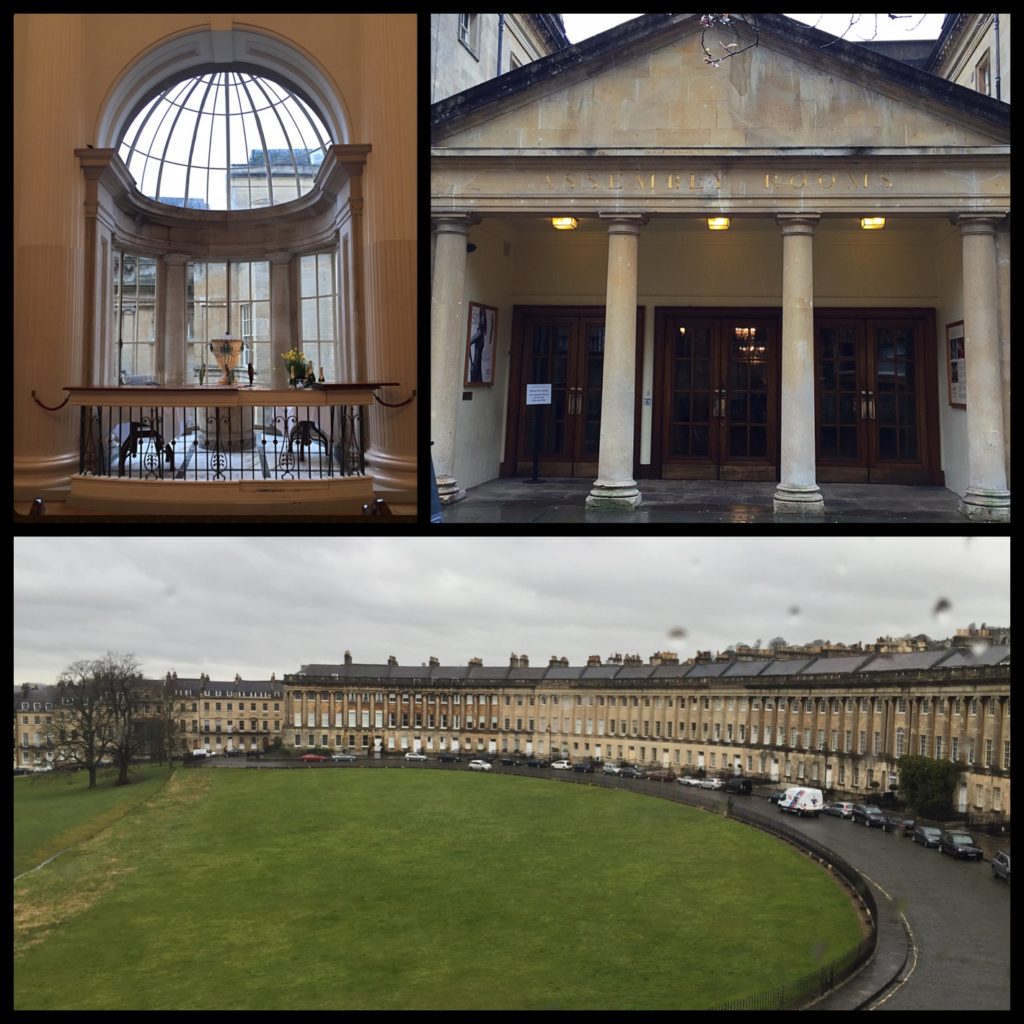
The Bath Assembly Rooms are still used for their original purpose, holding special events and galas. The basement holds a lovely museum on the history of fashion ranging from the 1500s all the way to present day. One of the highlights of Bath is No. 1 Royal Crescent. One of the coveted addresses on Royal Crescent, No 1 is now a restored Georgian manor and living museum. From the calling cards left on the front table, to the housekeepers quarters below stairs, it was amazing to see such care taken in the restoration of the house.
To learn more about Bath and one of it’s more famous residents, visit here.
4. Museum of London
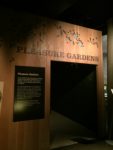 The Museum of London was also high on my list of places to see. A one of a kind museum, it boasts halls dedicated to the history of London from ancient times to present day. One such exhibit is and in-depth look at Pleasure Gardens. In the Georgian and Regency periods, pleasure gardens were the one place it was socially acceptable for both upper and lower classes to be seen together. An early precursor to amusement parks, they were not just gardens, but also had music halls, theatres, sit-down eateries, hedge mazes and fireworks. The most
The Museum of London was also high on my list of places to see. A one of a kind museum, it boasts halls dedicated to the history of London from ancient times to present day. One such exhibit is and in-depth look at Pleasure Gardens. In the Georgian and Regency periods, pleasure gardens were the one place it was socially acceptable for both upper and lower classes to be seen together. An early precursor to amusement parks, they were not just gardens, but also had music halls, theatres, sit-down eateries, hedge mazes and fireworks. The most 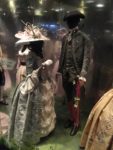 famous of the pleasure gardens was Vauxhall Gardens on the south bank of the Themes. Visitors of the upper classes would arrive via boat from the river and either pay a small fee to enter or display their seasonal coin, issued each year for frequent visitors. Those of the middle and lower classes would arrive by foot or carriage from the south entrance. The exhibit itself was unique in that it was in a darkened room. At first I thought it was to preserve the delicate silks of the gowns and jester costmes, but if you watch the walls, you find out the true reason… the walls come to life.
famous of the pleasure gardens was Vauxhall Gardens on the south bank of the Themes. Visitors of the upper classes would arrive via boat from the river and either pay a small fee to enter or display their seasonal coin, issued each year for frequent visitors. Those of the middle and lower classes would arrive by foot or carriage from the south entrance. The exhibit itself was unique in that it was in a darkened room. At first I thought it was to preserve the delicate silks of the gowns and jester costmes, but if you watch the walls, you find out the true reason… the walls come to life.
Yes, it’s true. There was a hidden projector showing a film on the walls; snippets of what life was like at the gardens. A family sitting down to a rare meal out — with Father complaining about the cost of the meal! — and a young lady and her mother looking at all the marriageable young men in attendance and planning which one they were interested in. All in all, a delightful experience.
Next week is the final instalment of It’s Reseach I Swear. Part 3 will have us back on home soil, sharing three local day-trips research ideas. Happy reading and I’ll see you next week!
Your Turn!
What’s the farthest you’ve travelled from home in the name of research?






5 comments